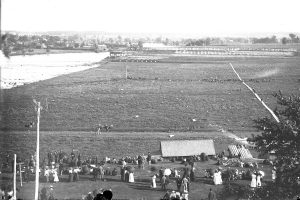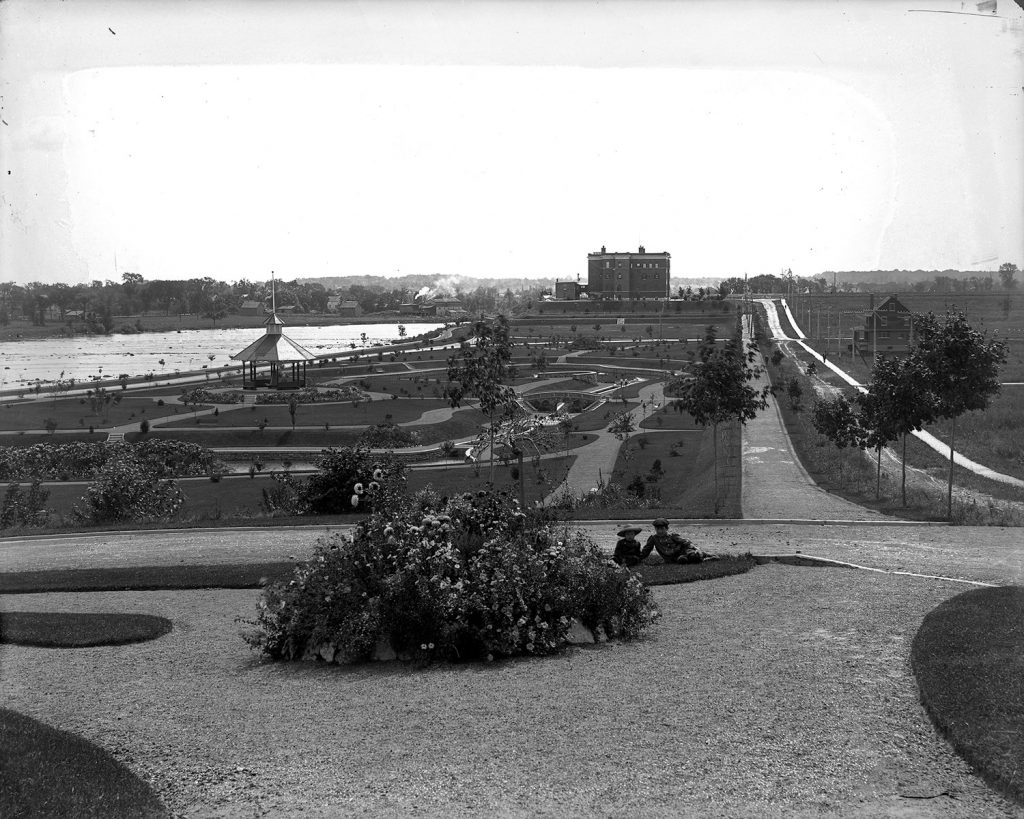The 15 acres of land that now form the park saw several uses in the 19th Century before being designated as a park. The park started as a swampy pasturage for the cows belonging to Sandy Hill residents and then became a rifle range in 1873. Lady Macdonald formally inaugurated the Dominion Rifle Range in 1890 and troops trained here until 1898. The name given to Range Rd., the street along the west side of the park, commemorates that use.
The following entry from Picturesque Canada paints a colourful picture of the shooting meets that took place here in the late 19th Century:
…”it is the scene of annual meetings of the Dominion Rifle Association, and … before its twenty targets the best shots of the country compete, selecting from their number the team that is yearly sent to contest at Wimbledon with the crack shots of Great Britain. During the week of the shooting, the city is in a state of martial furore; coats of red, dark-green and gray, are seen everywhere; the white tents of the association and of the different competitors picturesquely dot the ground; and the incessant crack of the rifle, the strains of military bands, the bright dresses of ladies, and the general charm of the unusual, give all the proceedings an animation for which the social world is the association’s debtor.” (Grant, 1882)

In 1891, enterprising local residents founded the Ottawa Golf Club, one of the oldest golf clubs outside Great Britain, and created a nine-hole golf course which hosted the first Canadian amateur golf championship in 1895. The following year, however, rising property values forced the Club to move to the Québec side of the Ottawa River.
The Ottawa Improvement Commission (precursor to the National Capital Commission) acquired these lands in 1904, drained and landscaped them, and built a gazebo, with waterways and two ponds. A landscape architect criticized this design as “meaningless, unsatisfactory in layout and vulgar in detail”. Expensive to maintain, the watercourses and ponds were removed in the 1940s and the crumbling gazebo in 1961. That was the year the NCC closed the park to vehicular traffic. A seasonal wooden footbridge that used to link the park to the Rideau Tennis Club also disappeared at that time. It has now been replaced by a permanent foot and cycling bridge (the Adawe bridge).
Starting in 1902, an isolation hospital for patients with contagious diseases existed at the south end of the park where an apartment building now stands (see photo below).

David Sproul, City of Ottawa Archives, MG397-G00529
Lord Strathcona donated the funds ($2,433) for the fountain standing near Laurier Ave. while he was Canadian High Commissioner in London[1]. It was unveiled July 1, 1909. The fountain was designed by French sculptor Mathurin Moreau and manufactured in France. A twin of it stands in downtown Buenos Aires. The four standing figures represent the four continents (Europe, Asia, Africa, America), a popular artistic allegory until the 19th C.
At the time of his gift, Lord Strahcona was serving as Canadian High Commissioner in London, capping an extraordinary career. Born Donald Alexander Smith in Scotland, Lord Strathcona worked for thirty years in the Labrador fur trade for the Hudson’s Bay Company, eventually rising to the position of chief commissioner. He would become active in countless companies over his long life. When the CPR was having difficulty raising the funds needed to complete its railway, Smith mortgaged his home and investments to the company. He is the one driving the last spike at Craigellachie. Seven years earlier, Prime Minister Macdonald had called him the greatest liar he had ever known and tried to punch him in the nose (In 1873, as a Conservative Member of Parliament, he had voted against his own government in the Canadian Pacific scandal.). Lord Stathcona went on to become a generous philanthropist, the president of the Bank of Montreal, the first chairman of the Anglo-Persian Oil Company (the ancestor of British Petroleum) and the chancellor of two universities (McGill and Aberdeen). He also raised a cavalry regiment out of his own pocket to fight in the Boer War[2]. He died at the age of 93.
Strathcona Park has long been a popular destination for Sandy Hill residents. It was one of the first parks in the city to allow children to play on the grass; it was also a place where one could find fossils along the riverbank. In 1985, it hosted Ottawa’s first Pride Picnic. Today, Strathcona Park includes a summer theatre, an arts and crafts fair, a wading pool and an award-winning play structure that echoes Mackenzie King’s ruin garden at Kingsmere. The baseball diamond at the south end of the park has existed since the 1920s and was for many years Ottawa’s main venue for the sport.
[1] He donated a second fountain that year that originally stood in Major’s Hill Park but has since been moved to Aylmer.
[2] Now an armoured regiment, headquartered in Edmonton.
